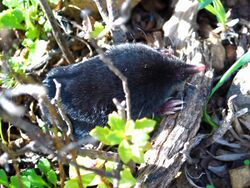Biology:Scapanus
| Scapanus | |
|---|---|

| |
| Broad-footed mole (Scapanus latimanus) | |
| Scientific classification | |
| Domain: | Eukaryota |
| Kingdom: | Animalia |
| Phylum: | Chordata |
| Class: | Mammalia |
| Order: | Eulipotyphla |
| Family: | Talpidae |
| Tribe: | Scalopini |
| Genus: | Scapanus Pomel, 1848 |
| Type species | |
| Scalops townsendii | |
Scapanus is a genus of moles in the family Talpidae.[1] They live in North America from west of the Rockies south to Baja California del Norte, and north to British Columbia, wherever conditions permit a mole population; that is to say, apart from the most sandy, rocky, or developed places. As they are one genus, they are very closely related, but as species, they rarely if ever interbreed successfully.
It contains the following living species:
- Mexican mole (S. anthonyi)[2]
- Northern broad-footed mole (S. latimanus)
- Southern broad-footed mole (S. occultus)[3]
- Coast mole (S. orarius)
- Townsend's mole (S. townsendii)
In addition, there are several extinct species known from fossils.
- Scapanus hagermanensis (Mid Blancan stage, Idaho)[4]
- Scapanus malatinus (Blancan-Quaternary, California)[5]
- Scapanus proceridens (Miocene, Oregon and Idaho)[6]
- Scapanus shultzi (Miocene, California and Oregon)[7]
Distribution
Townsend's mole is primarily a California n mole, although its range spills over into neighboring states. The broad-footed mole lives primarily in western Oregon, Washington, and southwestern British Columbia, where it often overlaps the smaller range of the Pacific or coast mole, which, as the name implies, does not tend to range as far inland. The broad-footed is one of the largest and most powerful moles, while the coast mole is a quite average-sized mole.
References
- ↑ Wilson, D.E.; Reeder, D.M., eds (2005). Mammal Species of the World: A Taxonomic and Geographic Reference (3rd ed.). Johns Hopkins University Press. ISBN 978-0-8018-8221-0. OCLC 62265494. http://www.departments.bucknell.edu/biology/resources/msw3/browse.asp?id=13700655.
- ↑ Yates, Terry L.; Jorge Salazar-Bravo (2004). "A Revision Of Scapanus latimanus, with the Revalidation of a Species Of Mexican Mole". Contribuciones Mastozoológicas En Homenaje A Bernardo Villa. Instituto De Biología e Ins Tituto De Ecología, Unam, México. pp. 479–496.. http://www.msb.unm.edu/mammals/publications/Yates%20y%20SBravo_Villa_book.pdf.
- ↑ Castañeda, Sergio Ticul Alvarez; Cortés-Calva, Patrica (2021-05-09). "Revision of moles in the genus Scapanus" (in en). THERYA 12 (2): 275. ISSN 2007-3364. https://www.revistas-conacyt.unam.mx/therya/index.php/THERYA/article/view/1174.
- ↑ Hutchison, J. H. (1987). "Late Pliocene (Blancan) Scapanus (Scapanus)(Talpidae: Mammalia) from the Glenns Ferry Formation of Idaho". PaleoBios 12 (45): 1–7. http://www.ucmp.berkeley.edu/museum/pbios/backissues/v12no45.pdf.
- ↑ Hutchison, J. H.. "Moles of the Scapanus latimanus group (Talpidae, Insectivora) from the Pliocene and Pleistocene of California.". Contributions in Science, Natural History Museum of Los Angeles County 386: 1–15..
- ↑ "Scapanus proceridens Hutchison 1968 (mole)". Paleobiology Database. http://www.fossilworks.org/cgi-bin/bridge.pl?a=taxonInfo&taxon_no=51422.
- ↑ "Scapanus shultz Tedford 1961". Paleobiology Database. http://www.fossilworks.org/cgi-bin/bridge.pl?a=taxonInfo&taxon_no=51423.
- Scapanus, IUCN
Wikidata ☰ Q2091646 entry
 |

